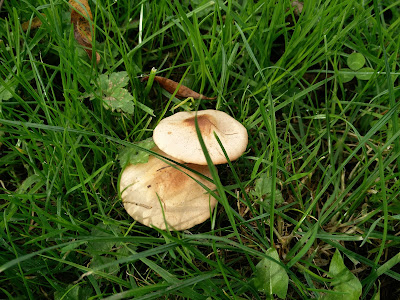I took a quick stroll around the village yesterday; ostensibly to get some exercise (I'm on a health kick) but these days I can't help but keep one eye out for mushrooms.
The big boxy Agaricus were back in Horton Wood but I ignored those. I spent ages looking at them last time they appeared (as evidenced here) and the main conclusion I came to is Agaricus are more difficult to identify than I thought they were. I think I need to get Geoffrey Kibby's book on 'The Genus Agaricus in Britain' to have a proper go at these, but it hasn't quite made it to the top of my fungus-related purchasing wishlist (which keeps getting longer).
But I did stop to look at these, growing on a grass verge. There had been a bit of rain and these were very slippery to the touch. The caps were slightly scaly, especially towards the centre, and around the edges hung obvious veil remnants.
With a few seemingly distinctive features, I thought these might be easy to identify so I took a specimen home for further examination.
It produced a brown spore print.
Since I brought them home yesterday the gills have turned a clay-brown colour and the stem has taken on a rusty colour towards the base.
Entering these features into MycoKey took me towards the Pholiota.
The macro features look quite promising for Sticky Scalycap Pholiota gummosa, as described in Roger Phillips 'Mushrooms'.
The spores look the right sort of shape and size too.
 |
| 1000x magnification. Spores are around 7 microns in length. |
But according to Funga Nordica, Pholiota gummosa should have some quite interestingly-shaped cystidia. I haven't had any luck finding these. All I've been able to find is loads of basidia.
 |
| 1000x magnification. Stained in congo red. |
*has one last look*
Oh wait! What are these...
I think those might be the cheilocystidia I was looking for.
And I this must be one of the "scattered" chrysocystidia.
By jove I think I might be able to confirm this as Pholiota gummosa after all. Go me! (This has only taken three hours.)
I think the next one's easier...
Beige caps again but with a pronounced tan-coloured nubbin (or 'umbo') in the middle.
The gills are free and distant, and produced a white spore print.
I think I'm on safe ground identifying this one as the Fairy Ring Champignon Marasmius oreades.
So, there we go. Turns out it's not just the little brown jobs that can be tricky: it's the medium-sized beige jobs too.
For the record
Date: 5 November 2017
Location: Small Dole (verge adjacent to the Shoreham Road)
Grid reference: TQ214131
Records entered into FRDBI 07/09/2018








No comments:
Post a Comment